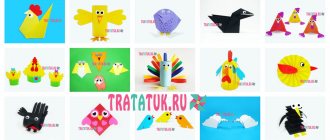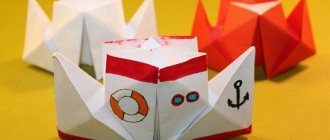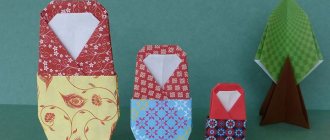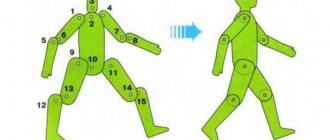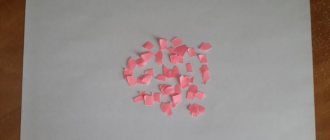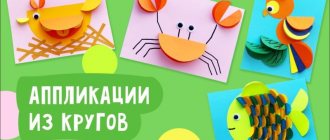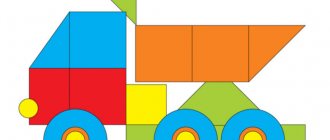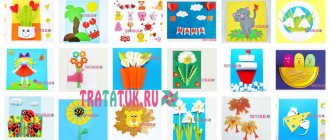Article Summary of GCD application in the senior group. Author: Yulia Sergeevna Gladkova
Author: Yulia Sergeevna Gladkova The abstract was developed with the aim of creating an image of a village street in a collective application, as well as enriching children’s knowledge about Moscow.
Used in an open lesson to show parents.
Brief description of the plot:
The fairy-tale character Carlson, having visited the Russian capital Moscow, flies to our native village to find a new home. He wants to live on a very beautiful roof, and the guys are invited to become architects and make Carlson's dream come true.
Children get acquainted with some buildings in Moscow and the profession of an architect.
Author: Yulia Sergeevna Gladkova Abstract of OD in the senior group Artistic creativity (application) Educator Gladkova Yu.S. Topic: Houses on our street Goal: creating an image of a village street in a collective application; enriching knowledge about Moscow - the capital of our Motherland Objectives: - learn to convey the image of a village street in applique - clarify ideas about the size of objects - practice cutting techniques in a straight line and along an oblique line - consolidate the ability to carefully use scissors, a brush, glue - develop the ability to work collectively , enjoy the results of your work - expand children’s knowledge about Moscow - introduce them to the professions of a builder and architect. Progress of the lesson: - Guys, a guest has arrived! The teacher shows Carlson - Do you recognize him? Where does he live? (On the roof) -Carlson told me an amazing story! It turns out that he just flew in from Moscow! -Do you know that this is Moscow? (Capital of Russia) -He visited the roofs of many famous buildings in Moscow. Here are just a few of them. Photos of the Bolshoi Theater, Borodino Panorama, and the Kremlin are hung. Children examine the features of architecture, their differences from each other and from ordinary houses -Who do you think created such beauty? (Architects, builders) - Guys, our guest seems sad. I think I know the reason. After all, Carlson loves to live on roofs, he has seen such beautiful buildings, he probably wants to live on the roof of some beautiful house, right? Carlson nods. - let's build Carlson a whole street of beautiful houses with comfortable roofs. You will all now turn into architects and builders! Physical Education Minute: -Shall we transform? Then repeat the movements after me: - We are cheerful guys, we love to run and play. We want to grow up quickly to become builders! We will build houses with windows and roofs, We will glorify Mothers for centuries, you will hear about us! -And now, dear builders, choose the material for your houses, think about what they will be like - large or small, high or low, how many floors and what kind of roof (the location of windows and doors is specified). And get to work. (Together with the children, we find a place in the overall composition of each individual application) - Carlson really liked your houses, he will live on all the roofs in turn! Who were you today? (builders, architects) -Carlson tells you: Thank you, guys! and is waiting for you to visit. And now it’s time for him to go to the roof. Goodbye! comments powered by HyperComments
What activities should you do with your child to teach him appliqué?
First give him a strip of paper and help him make the grass, that is, the cuts. From another strip you can make bricks or cubes. To do this you need to cut the strip completely.
Teach your preschooler to use glue, both liquid and solid. Show that glue can be applied to paper in different ways. You can glue the paper completely and along the edges and with dots.
Then you can move on to more complex figures. Teach him to cut out the shapes that make up most objects. For example, a triangle can be obtained by cutting a square diagonally (you get a sail). A trapezoid will turn out if you cut off the corners of a rectangle (you will get the roof of the house). A circle can be obtained if the corners of a square are gradually cut off by rounding (this is how you can get the sun or an apple). That is, strive to turn all activities into an entertaining game.
When folding paper, children do not pay attention to the position of the corners of the sheet of paper. You need to show the children that it will be correct to fold the corners and then use your fingers or palms to follow the fold line. Pay attention to this point.
The application has several stages of work, each of which is performed in turn. Before cutting, it is very important to see in your mind what the end result will be. Only after this you need to start cutting. You may even have to sketch out the outline of the image first. And you need to cut it out of a piece of paper that fits either in size or shape to the image that you have in mind. And already working with scissors, children should imagine what should happen. To develop such abilities in children, offer them tasks with obvious solutions. For example, if you give a child one small square of paper and one rectangle and ask him to cut out a pear and a berry, then he should imagine the result himself and realize that it is easier to cut a pear from a rectangle, and a berry from a small square.
Application of a man from geometric shapes
Different techniques allow you to captivate children of any age with applique. For the first experiment, an applique of a person made from geometric shapes is good.
This method of execution will help develop the child’s associative thinking, help him understand the shapes of body parts and identify similar shapes.
In the photo of the applique, a full-length person is shown using simple shapes made of colored paper. You can also use blanks made of fabric or thick cardboard.
To ensure that classes with your baby are as educational as possible, adults should use the following techniques:
- Say out loud the names of body parts, show them on the child’s body;
- Say the names of the figures and demonstrate their similarity to parts of the body;
- Help the child understand where this or that part of the body should be in space and place it correctly on paper.
As for practice, for younger aunts you need to prepare templates of geometric shapes, which all you have to do is glue them correctly onto a sheet of paper.
The places for gluing the figures can be marked on paper with an outline to make it easier for the baby to determine how to position the parts of the body relative to each other, or you can leave the baby a chance to determine for himself where the legs and arms of his person will look best.
Older children can be trusted to cut out geometric shapes themselves and place them on paper. As you acquire skills, the task can be complicated by asking your child to make a composition with the image of several people.
Basic tools and materials for appliqué classes
- The main material for applique is paper. And children become familiar with this material very early. By the age of three, a child knows the properties of paper well. Children need to be taught to see different images in paper. For example, you can lay out pieces of paper in front of your child and show him how to tear it into strips or pieces. At the same time, ask your child what each piece looks like (cloud, apple, hedgehog, etc.). It is necessary for the child to start practicing with paper and scissors. He can tear it, crush it, cut it. And you will ask him what he did and what it looks like. This will give him the independent experience he will need in his appliqué class. Material such as felt is also good for applique.
- Scissors. You need to take scissors that are safe for children, that is, with sheathed blades and non-pointed ends.
- Pencils and markers. They are needed for applying small drawings.
- Glue.
Teach your preschooler to hold scissors correctly. The correct way to hold them is with your thumb and middle finger, and children often try to grasp scissors with their thumb and forefinger.
You need to teach your child to work with scissors gradually. First, teach your baby to cut in the air. To make it interesting for your child, turn it into a game. For example, it could be a fish or a bird. Then show how scissors can bite, that is, cut paper. Be sure to warn children about the dangers of scissors. You cannot bring them to your face, you cannot throw them, you must pass them rings forward and always closed.
